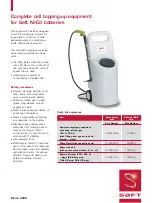
•
While the battery is being charged (cf. Section “Charging
Time”), the operation is carried out with
slowly falling
charging current
•
Unfit for gel batteries!
•
It is recommended to check continuously that the battery
charger power id adapted to the capacity of battery to be
charged. A charge too slow may demand too much time
for charging a battery. On the other hand, a powerful unit
may damage the battery.
Overload protection (pic. 2 and 3)
They have overload protection (a safety provision to protect
the battery charger from the effects of wrong connections or
overloading).
The overload protection device is a device to protect the
battery charger against failures and mishandling. It secures
safety of the entire circuit. If the device is enabled, it is
necessary to check to see whether all the instructions have
been observed
Important Notice! Replacement fuses, the resistance
values of which are different from the plate values, may
cause material and personal damage
The fuses replacement should not be done unless the
mains cable is unplugged. We shall not be held liable, not
even for the repair if the procedure is contrary to the
requirement
Fig 1
Fig 2
A.
Fuse A.
Fuse
B. Fuse
Residual Electrical Hazards
1.
Direct electrical contact
Defective cable one plug may cause an electrical
shock injury.
Have the defective cables and plugs replaced at a
specialist’s. Use the unit on a connection equipped
with a current protection (FI).
2.
Indirect electrical contact
A risk of injury by conductive parts with open or
defective parts of the unit
Disconnect the unit from the source of power to
maintain it. Operate with a current protection only.
3.
Insufficient Lighting of Workplace
Insufficient lighting always present a high safety
risk.
Always provide for sufficient lighting when working
with the unit.
Disposal
The disposal instructions are based on icons on the appliance
or its package.
Handling requirements
The operating staff must carefully read the Operating
Instructions before using the appliance.
Qualification
Apart from the detailed instruction by a professional no
special qualification is necessary for using the appliance.
Minimum age
Only persons over 16 years of age can work with the
appliance. An exception includes youngsters if they work
within their professional education the purpose of which is to
obtain knowledge supervised by a trainer.
Training
Using the appliance only requires corresponding training by a
professional or following of the Operating Instructions. No
special training is necessary.
Technical data
Connector:
230 Volt/50 Hz
Charging voltage:
12 Volt
Network performance:
200-1000 Watt
Charging current:
18 Amp.
Charging arithmetic current:
12 Amp.
Rated capacity:
150 Ah
Min. battery capacity:
20 Ah
Starting current 0 V:
100 Amp.
Starting current 1,5 V:
60 Amp
Weight:
5,0 kg
Transportation and Storage
•
If putting the unit away for a prolonged storage, it should
be cleaned thoroughly.
•
Securing the device in a clean, dry place
•
Protect the unit from weather effects with a tarpaulin,
carton etc.
Operation (pic. 4)
pic. 4:
1: Beginning of charging
2: In the course of charging
3: End of Chargign
4: Empty
5: Half-charged
6: Fully charged
Unplug before any adjustment and set up.
Charging
•
Connect the charger to the battery to be recharged
•
Always connect the black cable first, to the negative
pole. Connect the red pole cable to the positive pole.
•
The battery should be completely disconnected
from the vehicle before getting down to charging.
•
Always set the charger at the lowest charging degree
(min/1)
•
Now, plug in and control the charging degrees upwards
until charging current equal to ca 10% of the battery
capacity is displayed.
•
Charging degrees may be increased by falling charging
current.
•
Do not disconnect the battery from terminals later than
3-5 hours after charging is finished.
•
The charging current indicator will not come
back to zero after charging is finished.
NOTICE: The charging current should be ca 10 % of the
battery capacity!
(example: 88 AH battery
charging current ca 9 A)
Charging Time
•
Charging time is always dependent on the battery
condition (almost loaded, half loaded or fully unloaded)
•
To load "as a refresher" of a battery meet 2-4 hours. To
fully load requires 8-10 hours.
•
A maximum of 10 hours charging time should
not be exceeded.
Содержание START 170
Страница 2: ...1 2 3 4 1 A B 2 3 1 2 4 5 3 6 4 ...











































